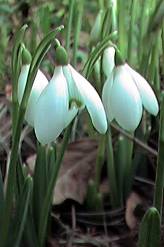
One of the very first flowers of the year, snowdrops can be out in the first week of January. They are probably not truly native here, but they have naturalised in a number of woods as well as on verges near houses. They seem to thrive particularly in light shade on slopes under trees. 31 Jan 2000.
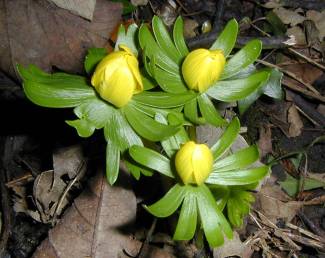
Winter aconites appear almost overnight, providing a very welcome splash of colour in January, often flowering with snowdrops. They have an underground corm, from which the yellow flowers and characteristic “frill” of leaves emerge, sometimes as early as Christmas. Aconites are not native to Ryedale, but they have naturalised in some woods and along driveways and verges. They are related to buttercups. 29 January 2000.
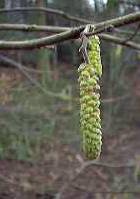
A hazel catkin pictured in February (left).
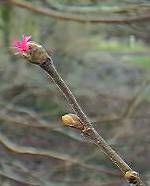 One of the first signs of spring. Hazel grows widely in our woodland and hedges. It is often coppiced (or has been in the past) leading to multi-stemmed bushes. The catkins contain the male flowers, and shed copious amounts of yellow pollen, which is wind-borne. The female flowers (right) are tiny, and look like little red brushes: these “brushes” are the stigmas on which the pollen will land to fertilise the female flowers, which ultimately develop into the familiar hazel nuts (which the squirrels usually eat!)
One of the first signs of spring. Hazel grows widely in our woodland and hedges. It is often coppiced (or has been in the past) leading to multi-stemmed bushes. The catkins contain the male flowers, and shed copious amounts of yellow pollen, which is wind-borne. The female flowers (right) are tiny, and look like little red brushes: these “brushes” are the stigmas on which the pollen will land to fertilise the female flowers, which ultimately develop into the familiar hazel nuts (which the squirrels usually eat!)  Feb. 99 (catkin); Feb 8 and March 14 2000 (females).
Feb. 99 (catkin); Feb 8 and March 14 2000 (females).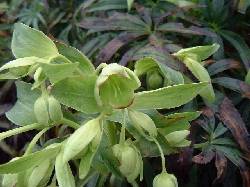
An uncommon relative of Christmas Roses, this hellebore grows in a few places in Ryedale at the edge of woodland paths, but may be an escape. It is not the same as the Green hellebore which also grows in the area, in woods. Feb 2000 (photo by Nan Sykes).
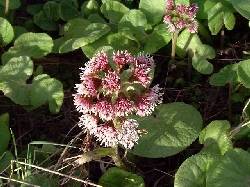
This heliotrope is probably a garden escape, and grows along roadsides. Most of the “local” population is well to the east, near the coast, but a few plants grow near Thornton-le-Dale. It is related to the larger, coarser Butterbur (see below). Feb 2000 (photo by Nan Sykes).
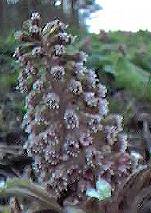
This is the native Petasites, sometimes known as Monk’s Rhubarb on account of its enormous leaves, which appear after flowering. It grows in damp ditches and marshy areas, sometimes in considerable patches. This plant is one of a group growing along the roadside near Gilling, in a damp patch 10/4/2000.
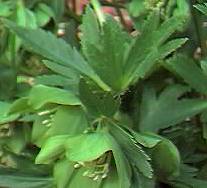
 Green Hellebore grows in a few places in old woodland on limestone. It is related to Christmas roses and resembles a small green version of these, usually flowering in February and March. The Stinking hellebore also grows rarely in our area. Photos 18 Feb 2000.
Green Hellebore grows in a few places in old woodland on limestone. It is related to Christmas roses and resembles a small green version of these, usually flowering in February and March. The Stinking hellebore also grows rarely in our area. Photos 18 Feb 2000.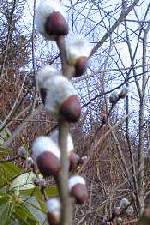
 The soft catkins of pussy willow appear before the leaves, often as early as mid-February. The ‘sallows’ or bush willows are a difficult group, with several very similar species which also hybridise with each other. This willow is probably Salix caprea, otherwise known as Goat willow. 24 Feb 2000. The photo (right) shows the male catkins after they have opened to reveal the yellow pollen (same tree, 22 March).
The soft catkins of pussy willow appear before the leaves, often as early as mid-February. The ‘sallows’ or bush willows are a difficult group, with several very similar species which also hybridise with each other. This willow is probably Salix caprea, otherwise known as Goat willow. 24 Feb 2000. The photo (right) shows the male catkins after they have opened to reveal the yellow pollen (same tree, 22 March).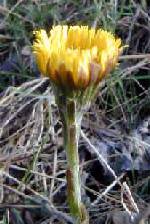
Coltsfoot flowers are some of the first to bloom in the year, along forest rides, on waste ground and roadside verges. The flowers appear well before the leaves (which are surprisingly large when they do emerge) any time from mid-February onwards. 24 Feb 2000.
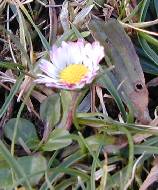
Probably the commonest wild flower we have! Daisies can actually be found in flower in every month of the year, and the flowers are very beautiful close up. Botanically speaking, the “flower” is in fact a collection or composite of numerous individual flowers, each with its own anthers and stigma; those in the centre of the flower-head are known as “disk florets”, and those round the edge bearing the white petals “ray florets”. The Daisy family or Compositae is the largest family of flowering plants. 23 Feb 2000.
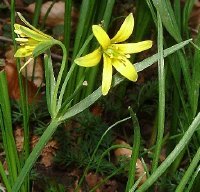
Photo © Nan Sykes 2003
A beautiful, delicate spring flower related to lilies. This rare plant, barely 4" tall, grows under trees in damp woods or grassland on limestone; previously known at two sites in Ryedale it was photographed (left) at a new local site in early April 2003. The photos below were taken on 16 March 2000 at one of the other locations.


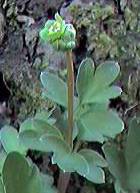
 This little plant some 3" high, also known as Town Hall Clock from the curious arrangement of the flowers, grows on grassy banks and at the edge of woodland. It indicates undisturbed ground. 27/3/99; 16/3/2000 (right).
This little plant some 3" high, also known as Town Hall Clock from the curious arrangement of the flowers, grows on grassy banks and at the edge of woodland. It indicates undisturbed ground. 27/3/99; 16/3/2000 (right).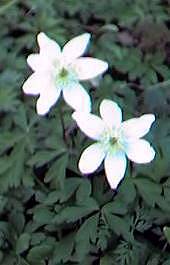
Common in old woodland, the wild anemone often carpets the ground. Some flowers develop a pink or purple tinge as they age. 29/3/99.
 The flower pictured right was growing on a roadside verge at the bottom of the hedge, near Yearsley; perhaps this indicates that this used to be woodland. 22/3/2000
The flower pictured right was growing on a roadside verge at the bottom of the hedge, near Yearsley; perhaps this indicates that this used to be woodland. 22/3/2000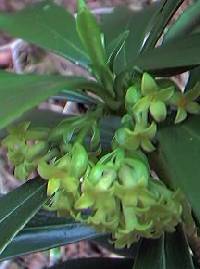
A relative of the garden Daphne, this small evergreen shrub has green flowers and black berries. It grows in old woodland on limestone and is fairly widely distributed in the southern part of our area. 27/3/99.
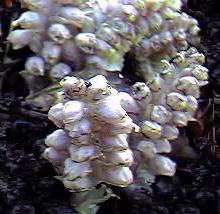
This curious pinkish plant lacks chlorophyll since it does not make its own food, being a parasite on the roots of shrubs, usually hazel, often growing in quite large clumps. It is quite common in Ryedale woodlands and old hedges. It is a member of the Broomrape family. 29/3/99.

A springtime favourite.
 Two distinct types of flowers grow on different plants, with the male or female parts visible respectively (the “other” partner, i.e. stigma or anthers, is hidden deep in the tube of the flower). This specimen (left) has the “pin” of the female stigma clearly visible; in “thrum-eyed” individuals (right) the male anthers are visible in the centre of the flower instead. Primroses are still common on sunny banks, hedges and in old woodland in Ryedale. 1/4/99 (left); 12/3/2000 (right).
Two distinct types of flowers grow on different plants, with the male or female parts visible respectively (the “other” partner, i.e. stigma or anthers, is hidden deep in the tube of the flower). This specimen (left) has the “pin” of the female stigma clearly visible; in “thrum-eyed” individuals (right) the male anthers are visible in the centre of the flower instead. Primroses are still common on sunny banks, hedges and in old woodland in Ryedale. 1/4/99 (left); 12/3/2000 (right). 
Sweet violets tend to flower before the dog violets.
 They occur in purple, blue and white forms, all of which bear the characteristic fragrance. They have blunt rather than acutely-pointed sepals which separates them from the dog violets, but not the similar unscented Hairy Violet. The white forms tend to be near settlements. 1/4/99; 16/3/2000 (right); 30/3/2000 (white).
They occur in purple, blue and white forms, all of which bear the characteristic fragrance. They have blunt rather than acutely-pointed sepals which separates them from the dog violets, but not the similar unscented Hairy Violet. The white forms tend to be near settlements. 1/4/99; 16/3/2000 (right); 30/3/2000 (white).

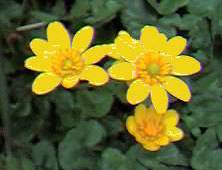
 One of the first springtime flowers, the bright yellow celandine is common along roadsides, in woodland and as a garden weed. 1/4/99 (left); 4/3/2000 (right).
One of the first springtime flowers, the bright yellow celandine is common along roadsides, in woodland and as a garden weed. 1/4/99 (left); 4/3/2000 (right). 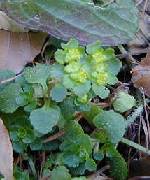
Golden Saxifrage grows in damp woodland, on ditchsides, and in similar damp environments, often carpeting the ground. The plant is small and creeping, and the individual flowers are tiny, but it can cover several square feet with a yellow carpet which is attractive. There are actually two closely related species: this is Opposite-leaved Golden Saxifrage. The Alternate-Leaved species ( C. alternifolium) also grows in Ryedale, though it is less common. It is a little bigger and lusher in general, and prefers limier habitats (below). 12/3/2000.

 Very similar to the commoner Opposite-leaved species (above), this little plant has rounder leaves on longer stalks, slightly larger flowers, and the characteristic single leaf on the flower-stalk; it is also somewhat less mat-forming, and grows in limier areas,chracteristically in small “flushes” (although this specimen is on a stream-bank near Hovingham). Very often it grows with its cousin, which at least makes comparing the two species easy! 12/4/2003.
Very similar to the commoner Opposite-leaved species (above), this little plant has rounder leaves on longer stalks, slightly larger flowers, and the characteristic single leaf on the flower-stalk; it is also somewhat less mat-forming, and grows in limier areas,chracteristically in small “flushes” (although this specimen is on a stream-bank near Hovingham). Very often it grows with its cousin, which at least makes comparing the two species easy! 12/4/2003.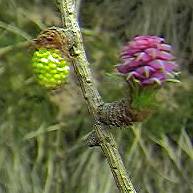
An unusual view of Larch, this picture shows a young male flower on the left, which will develop to produce clouds of pollen to be carried to the (separate) female flowers on the wind.
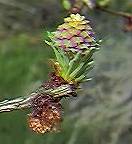 A pink female flower is seen to the right of the picture; it will develop into the familiar small cone after fertilisation. Another female flower, from a different tree, is shown in the photo to the right. This tree is probably the hybrid or Dunkeld larch, which is a cross between the European larch Larix decidua and the Japanese larch L. leptolepsis. 22/3/2000.
A pink female flower is seen to the right of the picture; it will develop into the familiar small cone after fertilisation. Another female flower, from a different tree, is shown in the photo to the right. This tree is probably the hybrid or Dunkeld larch, which is a cross between the European larch Larix decidua and the Japanese larch L. leptolepsis. 22/3/2000.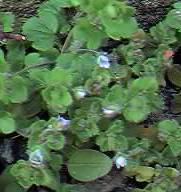
The archetypal weed! Small and weedy, an ephemeral which springs up, flowers and seeds within weeks, often managing several generations a year. The flowers are tiny and very pale blue or violet, each only lasting a day or so. The plant with its (roughly) ivy-shaped leaves is usually more or less prostrate. This specimen was growing as a weed at the base of a stone garden wall. 14/3/2000.

A rather boring green plant at first sight, dog’s mercury is nevertheless important because it is a good indicator of old undisturbed woodland; as such it is still common in Ryedale.
 The male and female flowers occur on separate plants (male, left and female, right); in my experience there are separate clumps of male and female plants – I wonder whether each group represents a clone of a single plant? It also seems to be the case that there are significantly more male than female plants. These particular specimens were growing fairly close together in woodland in southern Ryedale (near Gilling). 14/3/2000 and 30/3/2000.
The male and female flowers occur on separate plants (male, left and female, right); in my experience there are separate clumps of male and female plants – I wonder whether each group represents a clone of a single plant? It also seems to be the case that there are significantly more male than female plants. These particular specimens were growing fairly close together in woodland in southern Ryedale (near Gilling). 14/3/2000 and 30/3/2000.Later the female flowers develop rounded fruits (below) - which at least makes it easier to spot the rather elusive female plants! This particular specimen was growing at Hovingham and was photographed 21 May 2003.


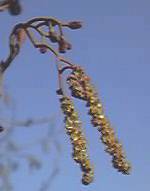 Alder is a common tree along watercourses, damp ditches and other wet habitats. The male catkins are superficially similar to those of hazel, but rather more reddish. The long male catkins produce the pollen, which is carried on the wind to the smaller, red female flowers seen above them (which are not reminiscent of hazel). After pollination these female flowers develop into small, woody cone-like fruits which persist on the branches for some time – which makes alders easy to recognise and identify! 18/3/2000.
Alder is a common tree along watercourses, damp ditches and other wet habitats. The male catkins are superficially similar to those of hazel, but rather more reddish. The long male catkins produce the pollen, which is carried on the wind to the smaller, red female flowers seen above them (which are not reminiscent of hazel). After pollination these female flowers develop into small, woody cone-like fruits which persist on the branches for some time – which makes alders easy to recognise and identify! 18/3/2000.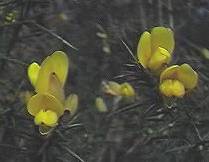
Gorse, also known as furze or whin, is common in Ryedale, growing along woodland rides and on scrubland, commons and similar places. It can be found in flower in almost any month, but the main season is spring, when whole banks can turn yellow and the scent is also noticeable. The flowers have the “butterfly” form common to the Peaflower family. The vicious spines deter animals from browsing the bushes. 22/3/2000
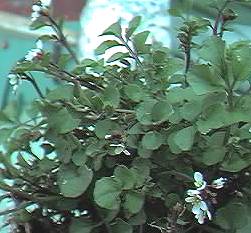
Another archetypal weed! Hairy Bittercress is also known as Jumping Cress or Popping Cress, referring to its almost magical ability to pop up anywhere – especially in garden borders, pathsides and similar habitats. (Alternatively these names may refer to the way the capsules pop to release the seeds, which jump out.) An unprepossessing little plant with minute white flowers, its foliage resembles tiny watercress leaves in both shape and taste. Bittercress is an ephemeral, quite capable of producing two or three complete generations in a year, and can be seen flowering at almost any time. 22/3/2000.
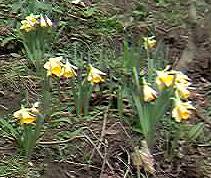
 The true wild daffodil is smaller and more delicate than its garden cousins, with the outer petals a pale primrose yellow and the trumpet a clear buttercup yellow (see detail right). Farndale is famous for its daffodils, but they also grow in other valleys and old woodland, often along streamsides – the bulbs are washed downstream in floods and grow wherever they find a new foothold. The plants in the pictures are along the riverbank near St. Gregory’s Minster. 22/3/2000.
The true wild daffodil is smaller and more delicate than its garden cousins, with the outer petals a pale primrose yellow and the trumpet a clear buttercup yellow (see detail right). Farndale is famous for its daffodils, but they also grow in other valleys and old woodland, often along streamsides – the bulbs are washed downstream in floods and grow wherever they find a new foothold. The plants in the pictures are along the riverbank near St. Gregory’s Minster. 22/3/2000.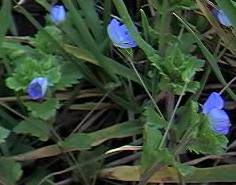
A common weed of farmland, this speedwell is not in fact native to Britain.
 It has relatively large flowers, clear blue with the bottom petal often pale or even white (see below, left), on long thread-like stalks. The plant is low and sprawling. This specimen was in a grassy field near Yearsley. 22/3/2000. (Detail, right from Gilling 30/3/2000)
It has relatively large flowers, clear blue with the bottom petal often pale or even white (see below, left), on long thread-like stalks. The plant is low and sprawling. This specimen was in a grassy field near Yearsley. 22/3/2000. (Detail, right from Gilling 30/3/2000)
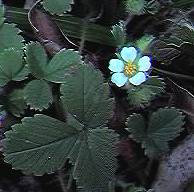
Barren Strawberry is actually a cinquefoil or potentilla, but its common name reflects its similarity to the true wild strawberry in flower. The white flowers are scarcely more than an eighth of an inch across; they are like miniature wild roses in form, with five slightly notched petals and a yellow centre to the flower. The whole plant is only a couple of inches tall and rather inconspicuous, but barren strawberry is very common on banksides, along paths, woodland edges and dry grassy areas. 22/3/2000.
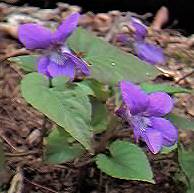
One of the two common dog violets, Wood Violet is the first to flower, usually in March. It grows in light shade in woodland or on banks, usually on limy soil. This violet is rather delicate in form, with a dark purple spur at the back of the flower. Dog violets have no scent and tend to be paler in colour than the Sweet Violet, and have sharply-pointed sepals. 16/3/2000.
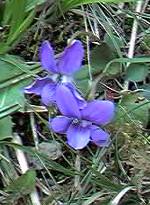
The other common dog violet, this is usually a week or so later to flower than the Wood Violet (above), in woods, hedge-banks, short grassland, even lawns that have not had weedkillers applied.
 The blue or mauve flower is rather rounder in shape than V. reichenbachiana, with a stout, pale, usually notched spur (this is almost impossible to photograph well!). 12/4/2003.
The blue or mauve flower is rather rounder in shape than V. reichenbachiana, with a stout, pale, usually notched spur (this is almost impossible to photograph well!). 12/4/2003.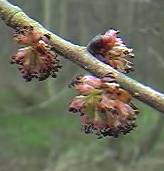
Elm, like many trees, produces its flowers early in the season. They are wind-pollinated, and so there are numerous anthers to produce the pollen. The purplish tuft is mainly composed of anthers, but the small green stigmas (the female part of the flowers) can just be made out. This is probably a wych elm, and was growing along the river bank in Kirkdale. 22/3/2000.
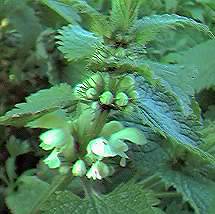
A common weed of hedge-bottoms and roadsides, a member of the large botanical family of Labiatiae (lipped flowers, the Thyme or Mint family).30/3/2000.
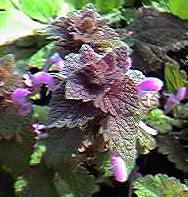
Another common weed of hedge-banks and roadsides, like its cousin the White dead-nettle (above). This particular palnt was growing at the edge of a field. 30/3/2000.

The true wild cherry, a very common small tree in Ryedale, especially in the woods on the limestone. The trees produce a mass of white flowers, usually in April, before the leaves. The fruit is normally red, small, hard and rather sour. The flowers grow in clusters rather than all along the twigs, cf. Blackthorn and Bullace/wild plum (see below). 30/3/2000.

Blackthorn or Sloe provides one of the first real signs of spring, when the bushes are covered in white flowers, which come before the leaves.
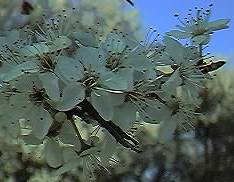 The bushes are viciously spiny, and very common in Ryedale’s hedges, scrub and woodland. In good years there is plenty of fruit (the bluish, bitter sloes used in sloe gin) but often the flowers do not seem to set much fruit, perhaps because of a lack of pollinating insects. 30/3/2000
The bushes are viciously spiny, and very common in Ryedale’s hedges, scrub and woodland. In good years there is plenty of fruit (the bluish, bitter sloes used in sloe gin) but often the flowers do not seem to set much fruit, perhaps because of a lack of pollinating insects. 30/3/2000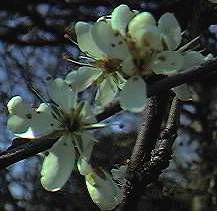
Wild Plum or Bullace is similar to Blackthorn, except that the flowers are a little larger, usually slightly creamy rather than white, and they come with the fresh new leaves rather than before. Wild plums are variable, sometimes growing from discarded domestic plum-stones, and form either bushes or quite large trees. The fruits vary in colour, shape and size, but are normally smaller and sourer than garden varieties. 30/3/2000

Often mistaken for a wild lilac, the bird cherry is locally common in Ryedale woods.
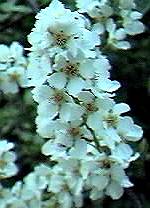 It forms a shrub or small tree and is a true Prunus cherry, actually quite closely related to the wild cherry (above). The individual flower-spikes (see right) are very attractive; the flowers have a strong almondy scent during their brief flowering season, usually only a week or so in early May. The fruit is in the form of small black “cherries” far too bitter for human consumption!. 29/4/2000
It forms a shrub or small tree and is a true Prunus cherry, actually quite closely related to the wild cherry (above). The individual flower-spikes (see right) are very attractive; the flowers have a strong almondy scent during their brief flowering season, usually only a week or so in early May. The fruit is in the form of small black “cherries” far too bitter for human consumption!. 29/4/2000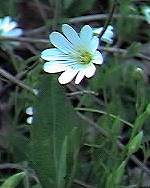
Great Stitchwort is very common in woods, hedge bottoms, roadsides and so on, usually appearing either with or just before the bluebells, and sometimes covering quite an area. The white flowers are showy, significantly larger than those of other stitchworts. The plant is rather weak-looking with thin, almost grass-like leaves.30/3/2000
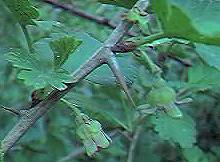
Gooseberry grows wild in Ryedale, being relatively common in woods and hedges. The wild plant has vicious 3-spined prickles, and tends to produce small, sour berries. The flowers are like those of the garden varieties – small, greenish-pink, hanging like tiny bells under the branches. 30/3/2000.
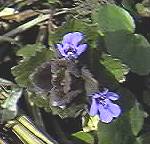
A very common little plant in the ground flora of woods and under hedges, also grows along verges and track-sides. It is a member of the labiate or mint family and has small, blue, two-lipped flowers. The neat, lobed leaves are thought to resemble ivy but to my eyes the likeness is not close. Late April 2003.